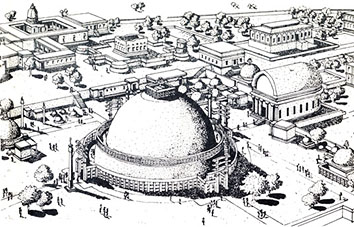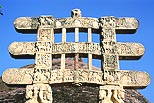|
A MAJOR BUDDHIST CENTER
On the small hill of Sanchi, approximately 9km from the ancient commercial town of Vidisha, numerous ruins of Stupas, temples, and monasteries lie scattered centering on Stupa 1, which is known as ‘Mahastupa’ (Great Stupa). Most of some fifty main structures are within the site, measuring about 380m x 200m, which is flattened out by ancient retaining walls.
When happened upon by British general Taylor in 1818, this site of Buddhist ruins had been left deserted for centuries, being covered with vegetation. It was not untill 1912 to 1919 that it was academically surveyed and excavated on a full scale. John Marshall (1876-1958), the third Director General of Archaeology in India, conducted the excavation and published a detailed, voluminous report in 1940.
This report revealed that the constructions at Sanchi were generally separated into two periods. The first was from the age of the Maurya Dynasty to the Shunga and Satavahana Dynasties, that is, from the 3rd century B.C.E. to the 1st century C.E., and the second was the ages after the Gupta Dynasty, from the 4th century to the 11th century. Therefore, Sanchi functioned as a major
Bhuddhist center during almost all ages in which Buddhism flourished in India. The reason why Sanchi prospered to the point that so many buildings were erected, despite no direct relation to Buddha’s life, might be the protection and patronage of merchants in Vidishar.

Reconstruction of the Sanchi Ruins
(From "The Architecture of India" by Satish Grover, 1980, Vikas)
Stupas of large, medium and small sizes, a horseshoe-type shrine,
and a courtyard-type monastery can be seen.
STUPA 1 (GREAT STUPA)
The principal monument at Sanchi is Stupa 1, which boasts the largest scale. It was constructed in the 3rd century B.C.E. at first, in the age of the Mauryan emperor Ashoka (r. c. 268–232 B.C.E.). Although it was half the size of the present one at that time, its body of baked bricks was enlarged a century later, in the age of the Shunga Dynasty, by being covered with sandstone. As a result, the Stupa attained an enormous scale: 16m in height for the ‘Anda’ (hemispherical dome) and 36m in diameter for the pedestal.
 Stupa 1 (Great Stupa) at Sanchi
Stupa 1 (Great Stupa) at Sanchi
The formation of the Great Stupa is as follows: the top of the Anda was cut flat and enclosed by a square fence to make a ‘Harmika’ (box-like structure), where a receptacle for ashes may have been buried, though the excavation did not find one. A ‘Stambha’ (upright) stands in the center, supporting a triple ‘Chhatra’ (umbrella).
It has been a form of worship in India since ancient times to circle clockwise around a ‘Chaitya’ (sacred place or object), and this passage is referred to as a ‘Pradakshina-patha’ (circumambulatory way). The Great Stupa has a double Pradakshina system. The 5m high upper-level passage is reached through a flight of steps in the south, on the railings of which remain a few reliefs. The lower passage is encircled with stone ‘Vedica’ (balustrades) over 3m high, which seem to have been made of wood in older times.
At the cardinal entrances to the Pradakshina stand four ‘Torana’ (monumental gateways) that are carved in reliefs across their surfaces. The figure of these gateways also looks like the substitution of stone for wood, showing itself as an archetype of a gateway.
STUPA 2
Stupa 2 stands on the hillside about 320m downward to the west of the Great Stupa. This might have been constructed during the end of the 2nd century to the 1st century B.C.E., indicating it to be the oldest of the three Stupas from the Shunga period.
The diameter of the Anda is about 14m. It has no Harmika or Chhatra, though it has been cut flat on top, but the excavation found a relic chamber holding four caskets for ashes made of steatite, on which the names of ten senior priests from the age of Ashoka are engraved.
Around the Stupa, Vedicas encircle the Pradakshina-patha, but there are no Toranas at the cardinal entrances. The most intriguing item in Stupa 2 is the collection of exuberant reliefs, such as medallions, carved on Vedica posts. The embellishing motifs are lotus flowers and other vegetation, as well as various animals.
 
Stupa 2 and 3 at Sanchi
STUPA 3
Stupa 3, which is located some 60m north of the Great Stupa, was built in the 1st century. As the diameter of its pedestal is about 15m, its scale is nearly the same as Stupa 2 as a whole. As if imitating the Great Stupa on a small scale, its formation was almost the same as that of the Great Stupa in old times, except that its Chhatra has a single layer, in contrast to the three of the latter. However, the outer Vedica has been lost and there remains no more than the South Torana among those of the four cardinal points at present.
In the small relic chamber in this Stupa were found two steatite caskets for ashes, on which the names of the foremost of Buddha’s ten disciples, Shariputra (Sariputta) and Maudgalyayana (Mahamogalana), were inscribed. There were some bone fragments, crystals, amethyst, pearls, and so on inside the caskets. They were brought to Britain and long after returned to India, and are now stored in a new temple on the hill of Sanchi.
TORANAS around THE GREAT STUPA
 A torana of the Great Stupa
A torana of the Great Stupa
The most remarkable objects of Buddhist art in Sanchi are the Toranas standing on the cardinal points around the Great Stupa. It seems that they were erected in the order of the south, north, east, and west in the early 1st century under the Satavahana Dynasty.
The main motifs throughout reliefs carved on these four Toranas are the life of Buddha, ‘Jataka’ stories depicting his previous lives, and Buddhist symbols. Various scenes and ornaments based on these motifs cover every nook and cranny of the surfaces of the two square pillars and three architraves of each Torana as if fearing to leave blank spaces.
 
Stone Carvings on Toranas of the Great Stupa
A king parading down a street with his retinue, swaying on a gorgeous saddle set on a grand elephant; an orchard custodian looking nonchalantly at elegant nymphs larking on the bow of a mango tree; farmers cultivating a field with simple implements and their wives bringing water with large vessels on their heads; a fantastic adventure of a monkey king and ‘an elephant with six tusks’; episodes like these are vividly depicted against the scenery of everyday life in the stone carvings.
In these reliefs, which can be called a ‘stone book,’ there are ancient Indian narratives based on some historical facts and also mere legends. Either way, through these urban and rural landscapes of the Malwa region to which Sanchi belongs, one can get acquainted with the rough state of towns and forts in one of the central regions of the Mauryan Empire.
Moreover, one can see a sculpture of Yakshini (female nature spirit rooted in pre-Vedic folk beliefs) on a bracket supporting a cantilevered architrave.
The best-prereserved Torana among the four is the northern one. A stone wheel protruding from the top of it symbolizes the ‘first sermon’ that Buddha preached after his enlightenment (preaching was often likened to turning a wheel) in Sarnath, the suburban town of Banaras (Varanasi).
In addition to this, one can see various kinds of symbols concerning Buddhism such as the Bodhi-tree under which Buddha received enlightenment in Bodhgaya and lotus flowers symbolizing the birth of Buddha. Since statues of Buddha had not yet begun to be sculpted in this age, that of Hinayana Buddhism, it was such symbols that followers used to worship.
TEMPLES and MONASTERIES
 
Temple 17 and Monastery 51, Sanchi
The Sanchi ruins offer not only Stupas, but also materials that reveal the figures of temples and Viharas (monasteries) of that era. Temple 17, built in the 5th century by the Gupta Dynasty, is a typical stone temple of the early medieval period in India. It resembles concurrent Hindu stone temples such as the Kankali Devi Temple at Tigawa considerably. They were the earliest buildings that India, which had theretofore been a land of wooden culture, began to construct with stones.
There is a porch with four pillars in front of the square shrine, but the Shikhara (tower over the shrine) had not yet been established.
Temple 18 is much larger than 17, but most parts have been lost, except for the foundation and some pillars. It is a Chaitya temple on a horseshoe shaped plan, and is surmised to have had a Stupa inside.
As for Vihara (monasteries), there were seven, one of which is monastery 51, located in a place about 7m lower to the west of the Great Stupa. It has a typical plan with an extensive open courtyard surrounded by cloisters and a range of monk’s cells. The lost columns and roofs seem to have been constructed of wood like other monasteries.
(In "UNESCO World Heritage" vol. 5. 1997, Kodan-sha )
|

